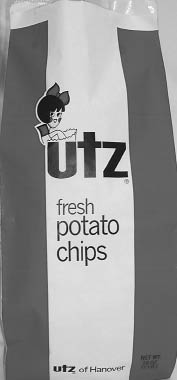It’s been said that anyone who claims to remember the 1960s obviously wasn’t there. But no matter what your lifestyle—straight (in the ’60s sense), Bohemian, or hippie—if you were alive in the 1960s, chances are you ate, and remember, California Dip.
This simple concoction reflects the ‘60s trend toward easy-to-prepare packaged foods. The essential ingredient was nothing more, or less, than a package of dried onion soup mix. Combined thoroughly with sour cream and chilled, it made for a delicious accompaniment to chips, crackers, or toast. The challenge was to find chips or crackers sturdy enough to stand up to a swipe through a bowl of this thick and creamy delight. Ridged potato chips were a perfect solution, and we recommend Utz brand potato chips (ridged or regular), a staple in the Draper household and a major account at Sterling Cooper, for an authentic Mad Men experience. Founded by Bill and Sallie Utz in 1921, Utz isn’t nearly as big a company as Frito-Lay or Wise, but it’s a leading regional brand in the mid-Atlantic and Northeast.
In one of the most unforgettable scenes in Mad Men, Utz’s owner Hunt Schilling and his wife, the very heavy-set Edith, visit Sterling Cooper to watch acerbic comedian Jimmy Barrett film an Utz commercial (“Utz are better than nuts!”; season 2, episode 3; “The Benefactor.”) (For the record, Utz was never owned by anyone named Schilling.)
When Jimmy sees the overweight Mrs. Schilling, he launches into a vicious rant about her weight, at one point comparing her to the ill-fated blimp Hindenburg. The misstep nearly costs Sterling Cooper the account, salvaged only thanks to a carefully staged apology over dinner at Lutèce delivered by Jimmy but arranged by Don Draper (see Lutèce Gambas au Beurre d’Escargot).
According to Jean Anderson, author of the American Century Cook Book (Clarkson Potter, 1997), the idea of mixing Lipton’s Onion Soup Mix and sour cream came not from Lipton’s, but from an anonymous California cook (hence the name, California Dip) in 1954, two years after the soup mix first appeared on supermarket shelves. “Word of the new dip spread through Los Angeles faster than a canyon fire,” wrote Anderson, “newspapers printed the recipe, onion soup mixes sales soared, and Lipton executives, a continent away in New Jersey, were ecstatic. They tracked down the recipe, perfected it, and beginning in 1958, printed it on every box of Lipton Recipe Secrets Onion Soup Mix.” The location of its invention was a fortunate one: California was the hip, trend-setting state in the 1960s—the place to be or to emulate—and “New Jersey Dip” would likely have been a huge market failure.
In “Red in the Face,” Paul Kinsey and Ken Cosgrove cajole Pete Campbell into opening a box containing a duplicate wedding present he and Trudy have received, one that will take some effort to return. Inside the box is a garish ceramic serving piece that looks like two large lettuce leaves joined at the base, onto which is mounted a ceramic tomato with a removable top. Paul and Ken are astonished; they can’t believe Pete and Trudy received two identical monstrosities.
“What is it?” asks Ken.
“You have your friends over. You put chips in the sides and dip in the middle.”
“Dip?” says Ken incredulously.
“Yes,” Pete explains. “We went to these people’s house and they had one. It had sour cream with these little brown onions in it. It was very good.”
“You’ll have to give me that recipe sometime,” counters Ken, though it’s hard to tell if he’s serious.
Well, here you go, Ken—just in case.

A PACKAGE OF UTZ POTATO CHIPS CIRCA 1960